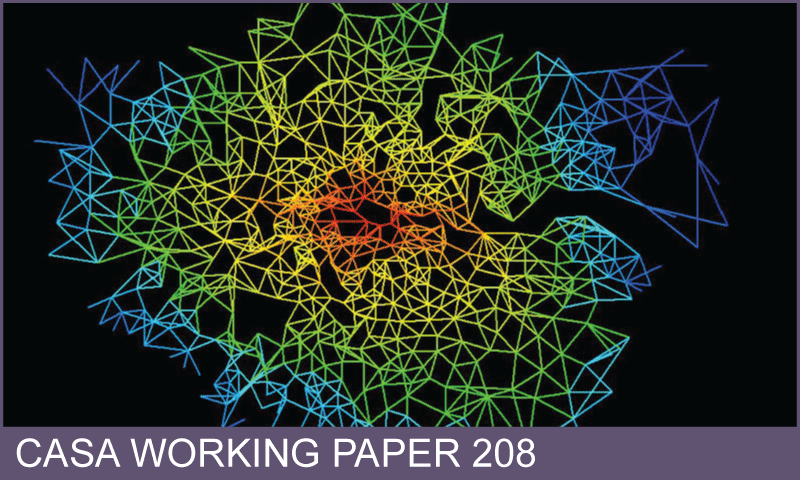CASA Working Paper 208

1 February 2017
Space Syntax and Spatial Interaction: Comparisons, Integrations, Applications
In this paper we attempt, somewhat optimistically perhaps, to compare space syntax with spatial interaction. At one level, these two approaches to urban spatial structure are non-comparable. Space syntax is largely a descriptive technique for visualising spatial relations at the level of connections between places while spatial interaction is a predictive model that forecasts how much travel there will be between places.
Space syntax articulates the system in terms of whether or not a physical link, usually at the level of the street system, exists while spatial interaction predicts movement between all origins and destinations which are places usually anchored in terms of the street network, but which at the level of prediction assume connections between all places. Space syntax tends to be grounded at a fine spatial scale while spatial interaction defines places as aggregates of activity in much larger zones than the scale of the street system.
The main output of space syntax is a connectivity matrix of step lengths between streets whereas in spatial interaction, such networks are predetermined, measurable in terms of Euclidean distance or generalised cost of travel, while the output is the volume of travel prior to this being assigned to the relevant modal network. However both approaches define accessibility, in space syntax in terms of streets while in spatial interaction in terms of places or zones.
There is however a fundamental way of relating the implicit network graph of spatial interaction to the explicit planar type graph of the street network by assuming the planar graph of the network is conceived of as a primal problem of spatial interaction while the dual graph linking streets in the planar graph is the graph which is used in space syntax. We exploit this duality and show how we can move easily between spatial interaction and space syntax from primal to dual and back again.
This is grounded in a more fundamental graph which is the bipartite graph or list of streets/arcs and their intersections/nodes from which the primal and dual emerge naturally. We explore various distance and accessibility measures and show how they relate and correlate. We then go one step further and consider how various processes of random walking take place in these networks and look at the steady states of the primal and dual problems in terms of the likelihood of a random walker visiting any node or street.
We define primal and dual Markov chains that enable us to generate these probabilities although there is some controversy as to whether higher values are associated with more important nodes. Nevertheless, this provides a basic framework for comparing primal and dual in comparing spatial interaction with space syntax. We illustrate these measures on simple and easy to articulate graphs and then extend this to a synthetic network of nearest neighbour links in Greater London based on some 699 nodes and 1972 symmetric street or routes/links between zones.
We also speculate how we might begin to compare the predictions from related spatial interaction models with the street accessibility values from space syntax and in doing so, suggest that that there are ways forward in comparing outputs at the level of movement on links, notwithstanding that these two approaches exist at different level. This paper is a preliminary attack on the problem of linking these two approaches which remains problematic.
Author: Michael Batty
Publication Date: 01 February 2017
 Close
Close

